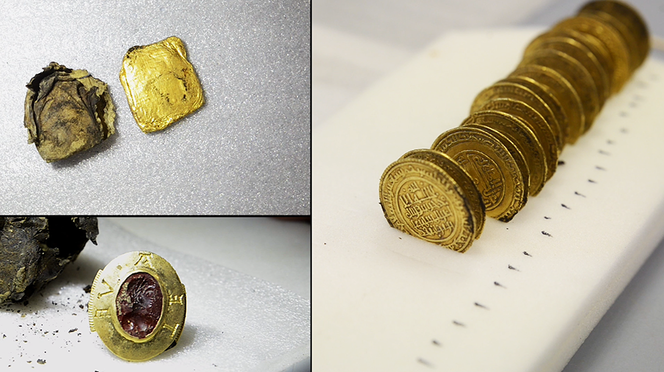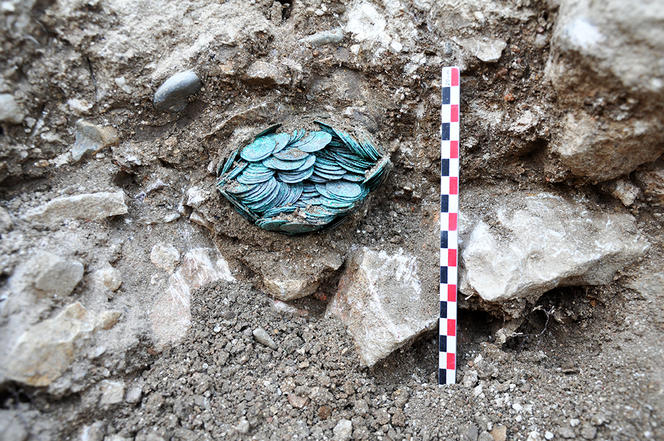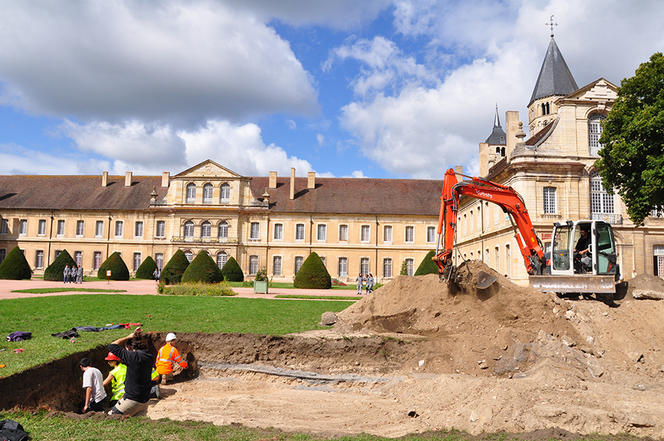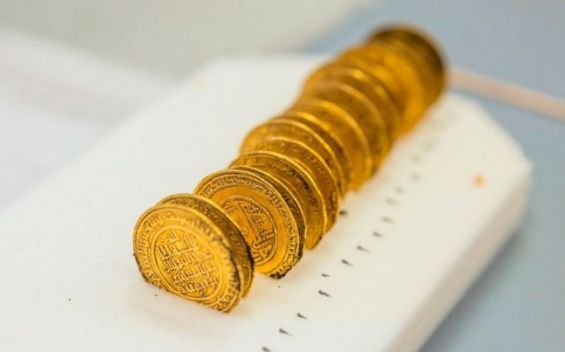In the vicinity of the Cluny Abbey, a former Benedictine monastery in Cluny, Saone-et-Loire, France, a team of archeologists from the Lumiere University Lyon 2, has found a medieval treasure dating back to the 12th century. While leading an excavation in the old infirmary location, the Archeologists stumbled upon a hoard of gold and silver hidden just a few centimeters under the ground.
According to an article issued by the National Center Scientific Research (CNRS), after two months of examination the discovery made in September has finally seen light. Reportedly, the excavated hoard contained 2,200 silver coins, 21 gold dinars, a gold signet ring, with a Roman intaglio, a foaled piece of gold leaf, and a small gold object.
Islamic dinars
The most surprising fact about the recent discovery is that some of the golden coins are Islamic with words in Arabic engraved on them. Moreover, all of the dinars and coins discovered are believed to be minted in the first half of the 12th century. A surprising find for the University’s team which had a different plan at the beginning of the excavation.

«We were focusing on the infirmary, an important part of the abbey that functioned like a small monastery within a larger one», said Anne Flammin, a CNRS engineer. To put it in other words, the archeologists were looking for traces of the old building which used to house «sick or elderly monks, who were subject to different rules», said Flammin.
During the aforementioned operation, an MA student saw a coin emerging from the stratigraphy. «We stopped everything and started digging by hand», states the CNRS engineer.
Moroccan dynasties in Spain
Explanations started emerging after discovering the valuable coins. According to the same source, «the dinars were minted between 1121 and 1131 in areas of Spain and Morocco controlled by the Berber Almoravid dynasty».
Meanwhile, Vincent Borrel, a PhD student working at the AOROC, explained that «the treasure should have been enough to buy three to eight horses, the equivalent of the same number of cars today. It’s a considerable sum for an individual, yet it is by no means colossal on the scale of the abbey, for which it would have represented only a week’s supply of wine and grain for the monks.»

The discovery indeed has pointed out to the Islamic presence in Andalusia (Spain nowadays), the National Center for Scientific Research insists that «the 21 gold coins in the cache came from the vast region of Islamic Andalusia, at a time when the Christians had reclaimed about half of Spain».
«The Order of Cluny had priories in the Christian areas, and one of them could have sent back the dinars following transactions with the Andalusians. The hypothesis of a direct donation from the Christian kings of Spain has also been proposed».
Indeed, historical accounts give an outline of Islam in Spain. Following the famous Umayyad Conquest of Hispania in the 8th century, Islamic dynasties have taken turns controlling the Iberian Peninsula. The Almoravid dynasty, an imperial central dynasty based in Morocco, stretched during the 11th century over the Western Maghreb reaching Al-Andalus. The Almoravids were crucial in preventing the fall of Al-Andalus to the Iberian Christian kingdoms, when they decisively defeated a coalition of the Castilian and Aragonese armies at the Battle of Sagrajas in 1086.

Although the Amoravids were kicked out of Spain by the beginning of the 11th century, Almohad Caliphate took control of Al-Andalus. They transferred the capital of Moslem Iberia from Córdoba to Seville founding a great mosque there.
Not the first discovery
The treasure found in Cluny is not the first discovery linked to Islam. In February 2016, three Muslim tombs were discovered during excavations in Nîmes. They were the oldest discoveries in France and the first clues to the presence of Muslim communities in the south of the country at the beginning of the Middle Ages, between the 7th and the 9th century. DNA analyzes indicated that the fossils were originally from North Africa.





 chargement...
chargement...












